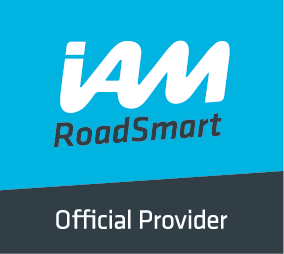Read our useful driving tips provided by Mark Farnworth, Group Vice-President or from other Group members or IAM RoadSmart where stated.
Browse by topic (click to view and then press back arrow)
ABS, Books, 'Automatic' Gearboxes, Dual carriageways, Country driving, Eco driving, Green traffic lights, Handbrake, Horses, Indicating, Motorway driving, Observation, Overtaking, Roundabouts, Signalling, Spoken thought, System of Car Control, Terminology, Town Driving, Traffic lights, Vehicle balance
Dealing with roundabouts
Applying the 'System' to Roundabouts
Let us suppose that you are on a dual carriageway approaching a roundabout (400m away). You are currently in the left lane and you intend to turn right at the roundabout. Information: - Take - You see the roundabout and its triangular warning signs in the distance. There are no vehicles between you and the roundabout but you see vehicles on the roundabout. Mirror check. There are two vehicles behind, both in the left lane. - Use - You know that you have to change to the right lane and that you will need to signal to change lane and then to signal continuously on the approach and through the roundabout (the standard Highway Code procedure for turning right at a roundabout ) - Give - After checking your mirrors you signal right to the vehicles behind.
Position: The right signal remains on for a few seconds and then gradually you move to the right hand lane (Information-Use/Give). When the manoeuver is complete you cancel the signal. After a few more seconds the right signal is re-applied to confirm to the drivers behind that you intend to turn right at the roundabout.
Information: The speed and position of the vehicles behind are monitored as you approach the roundabout. An assessment is made of the movement of vehicles on the roundabout and those approaching it from the right and left. You look over the roundabout to see, if possible, vehicles approaching it from the opposite direction (Information-Take).
Speed: As you approach the roundabout you begin to brake and lose speed smoothly and progressively (Information-Give). Before you start braking you check your mirrors (Information-Take). You aim to time your approach to the roundabout so as to 'slot-in' to the flow of traffic using it (Information-Use).
Gear: You commit yourself to a gear change when you know that you will be able to enter the roundabout. If you have to 'hold-back' you will brake more and so your approach speed will be less. The more you need to hold back the lower is your approach speed and the lower will be the gear selected when the roundabout is clear for entry. The extreme case is when you have to stop at the Give Way line, in which case you select 1st gear for entry. The approach procedure is a continuous re-assessment of the speed and position of vehicles using the roundabout (Taking and Using Information). The selected gear should be appropriate enough to take you through the roundabout without a further need to change gear. However, selection of a higher gear on the roundabout may be necessary, particularly if the entry gear was 1st or 2nd. Changing gear should be carried out when the steering is constant (simultaneous movement of the steering wheel with gear changing must be avoided). On entry to the roundabout, you move to the inside (right) lane and remain there (signalling right throughout) until the exit before the one you wish to take. A mirror check and a look over your left shoulder lets you know what is behind and what is in your mirror blind spot. (Information-Take). You signal left to inform vehicles behind or those waiting to join the roundabout, of your intention (Information-Give). You change to the outside (left) lane and leave at your exit.
Acceleration: The gear used on the roundabout is used to increase speed away from the roundabout. As you exit, you look out for a change of speed limit signs or for approaching hazards (Information-Take) which may require you to moderate your speed (Information Use/Give).
By Mark Farnworth
Mini-Roundabouts
Approach these as you would a normal roundabout but remember there is less space and time to signal and manoeuvre. There will be occasions when it is difficult to signal left when leaving a mini-roundabout. You should give way to vehicles coming towards you who want to turn right. Be certain that any vehicle on the roundabout is going to leave it before you join the roundabout. Look out for drivers who are using the roundabout for a U-turn. Remember that larger vehicles might not be able to avoid driving over the marked centre area. In wet conditions this painted area is likely to be slippery and present a risk of skidding. Avoid it whenever possible.
Double Mini-Roundabouts: (An example can be found in St Helens at the junction of Leach Lane and Mill Lane/Reginald Road).
View on Google Maps
Don't enter the first roundabout until you are sure you can enter and exit from the second without stopping or interfering with other traffic. Take full observations before you enter.
Multiple Roundabouts:
At some complex junctions, a large roundabout can incorporate a series of mini-roundabouts at the intersections. Take extra care because traffic can be travelling in all directions around the large roundabout. You must make full observations and assess the situation at each mini-roundabout. Look for direction signs well in advance.
By Alan Prescott
Disclaimer: Driving is never a black and white activity, but full of grey areas, therefore neither I nor my fellow Observers in the St Helens & District Group of Advanced Motorists are liable for any consequences you may experience as a result of reading our advice. You are the driver. You should be in control of your vehicle at all times.

